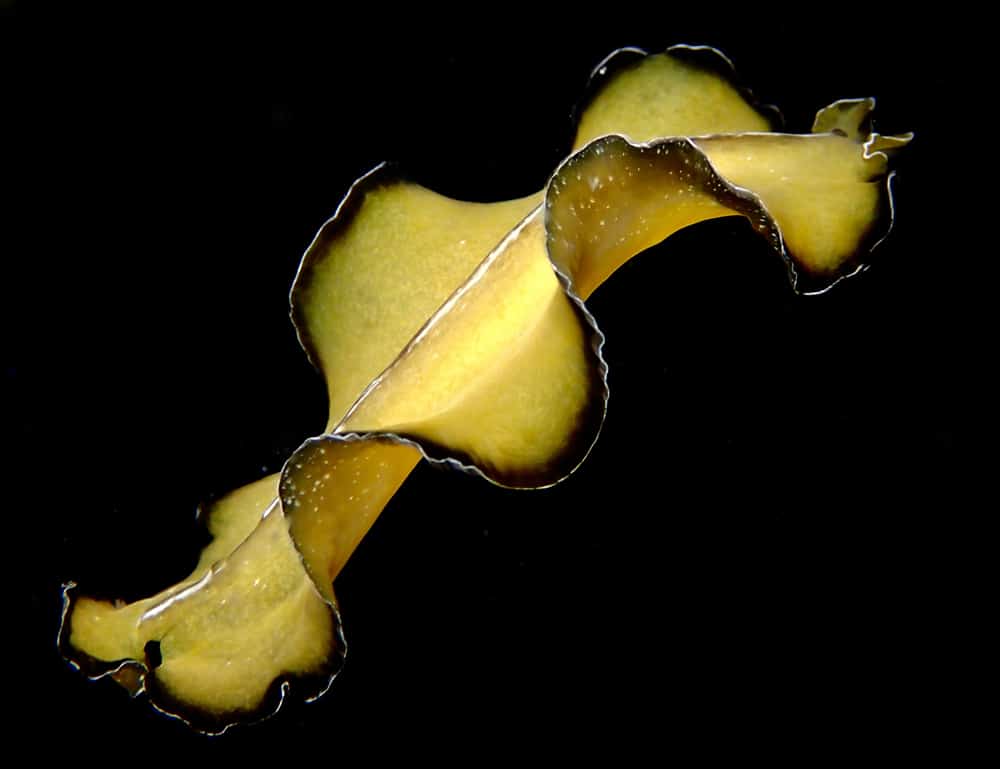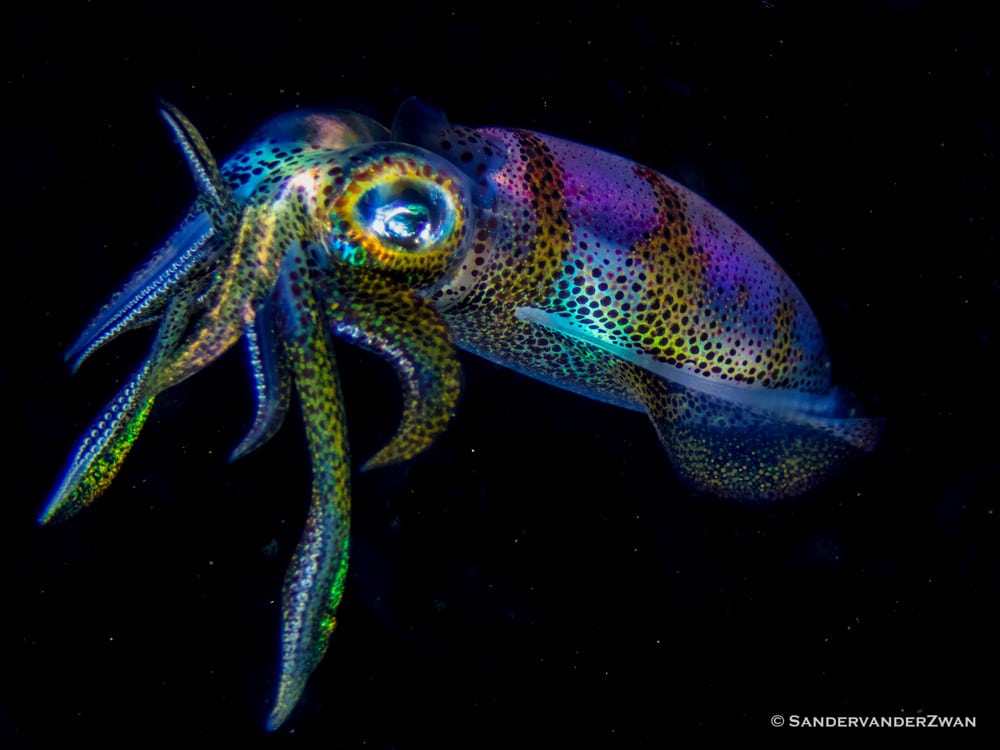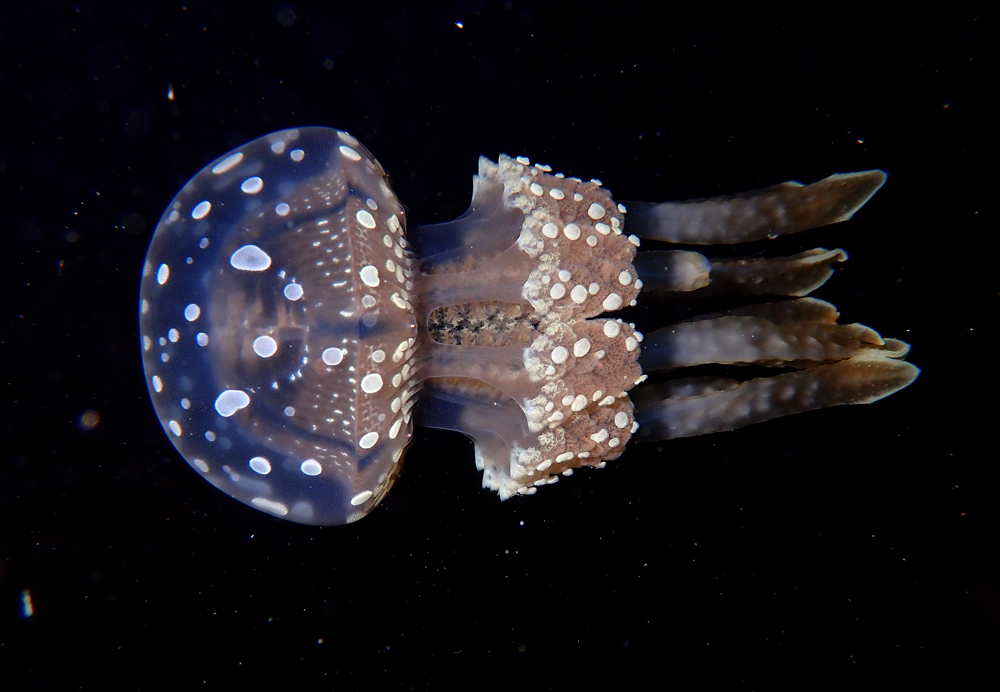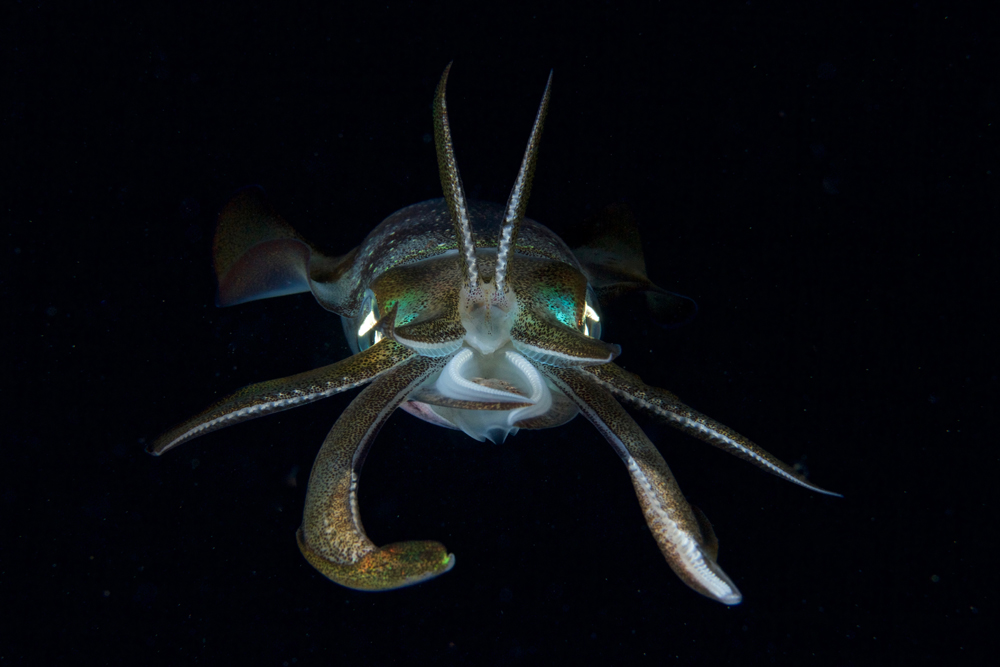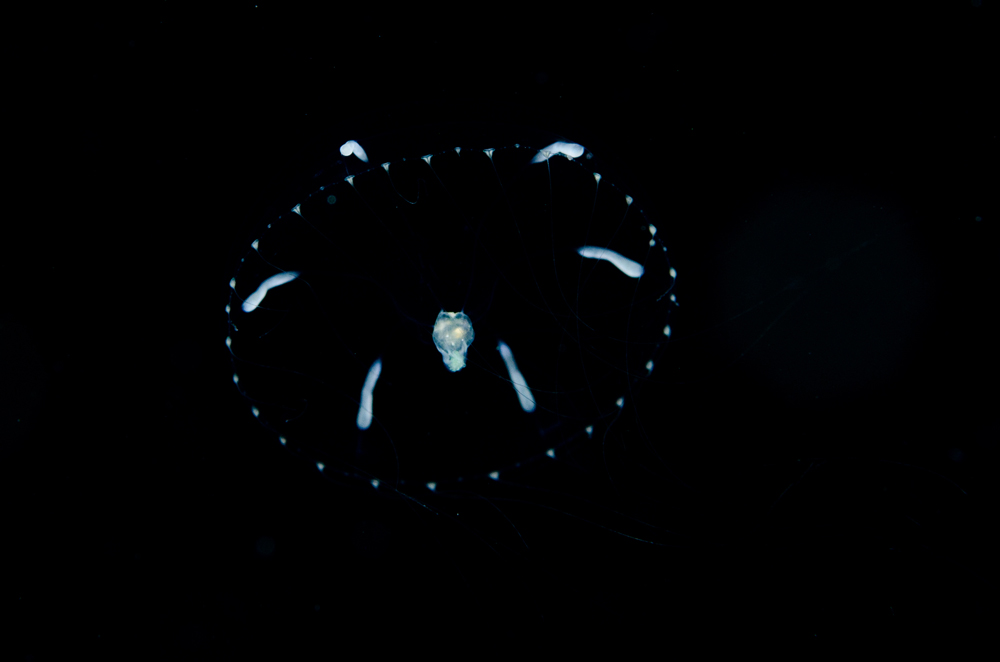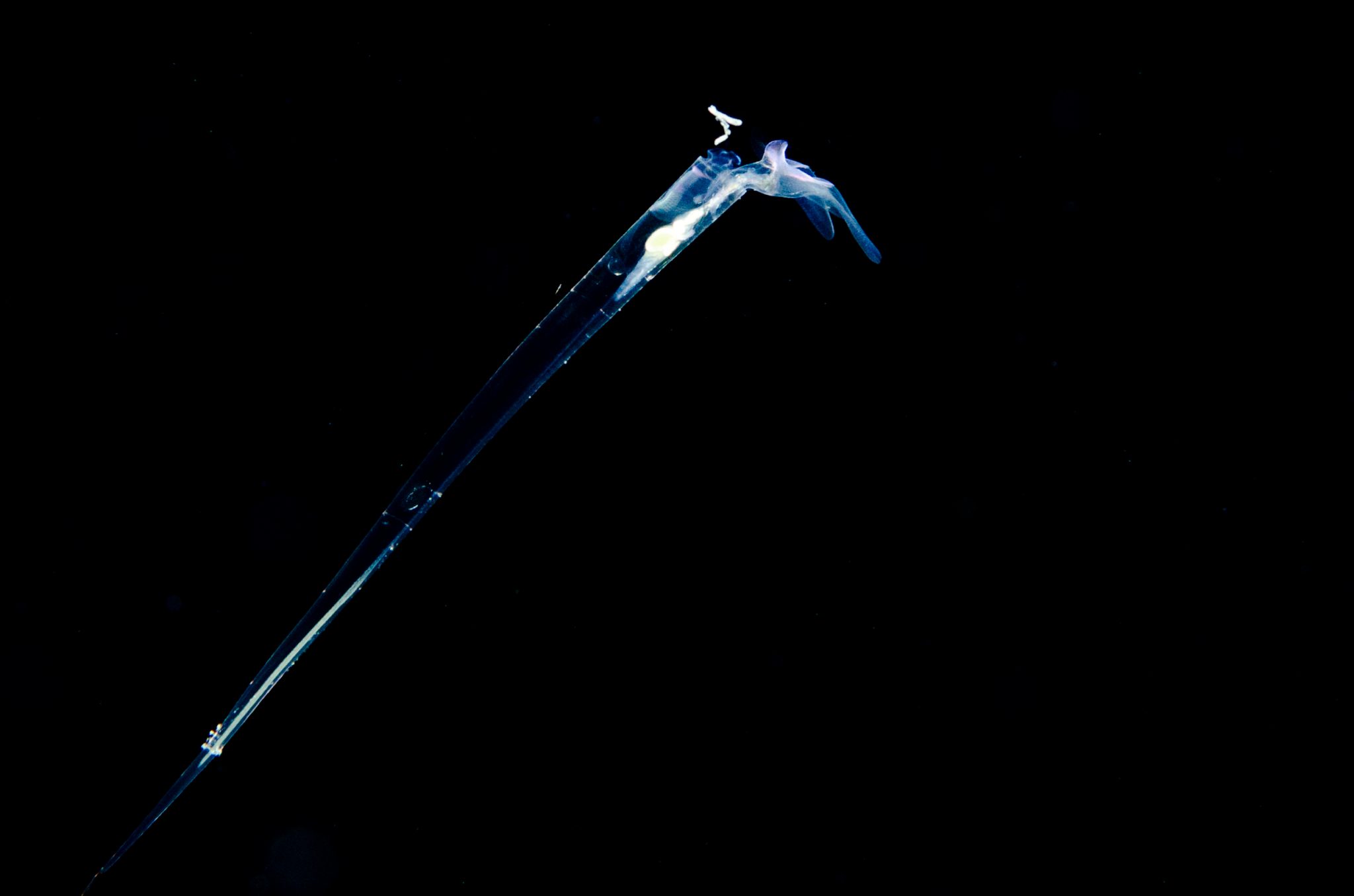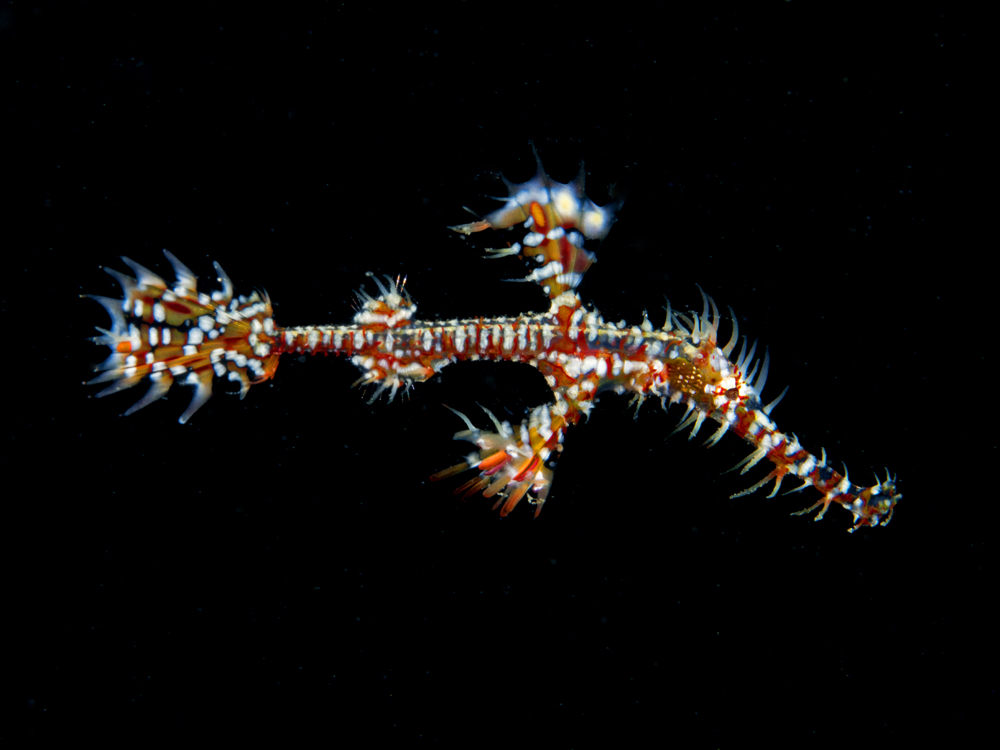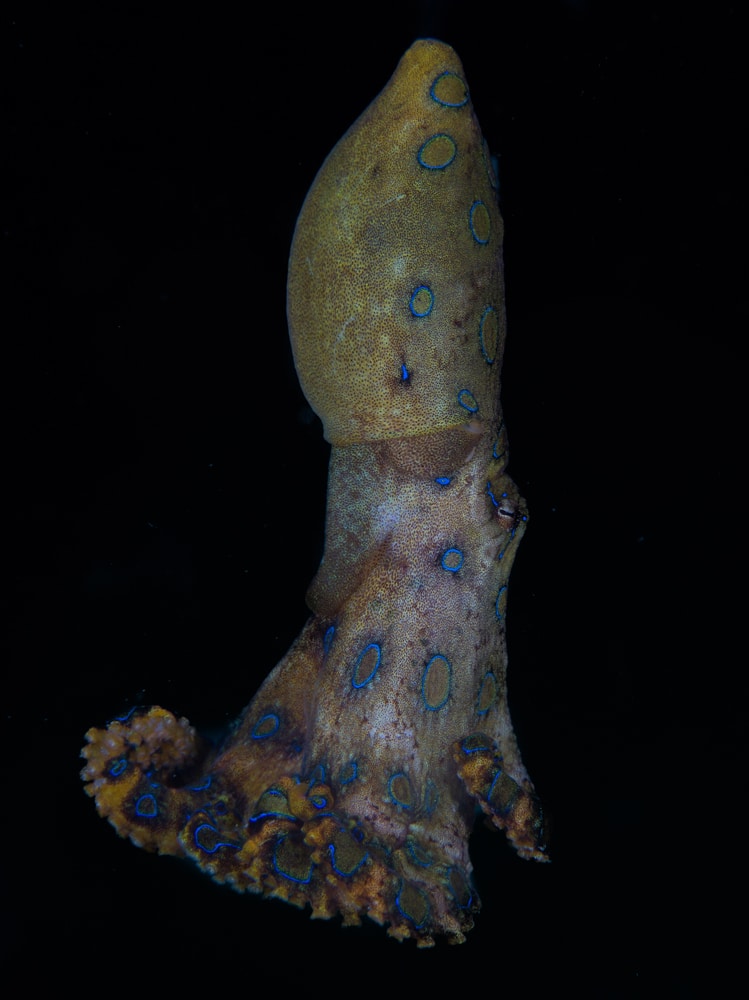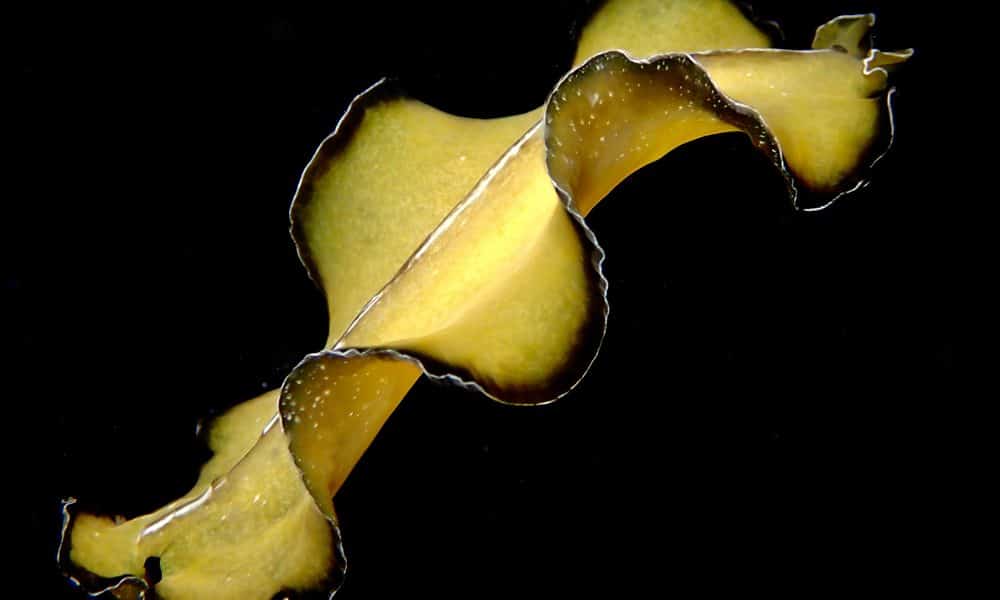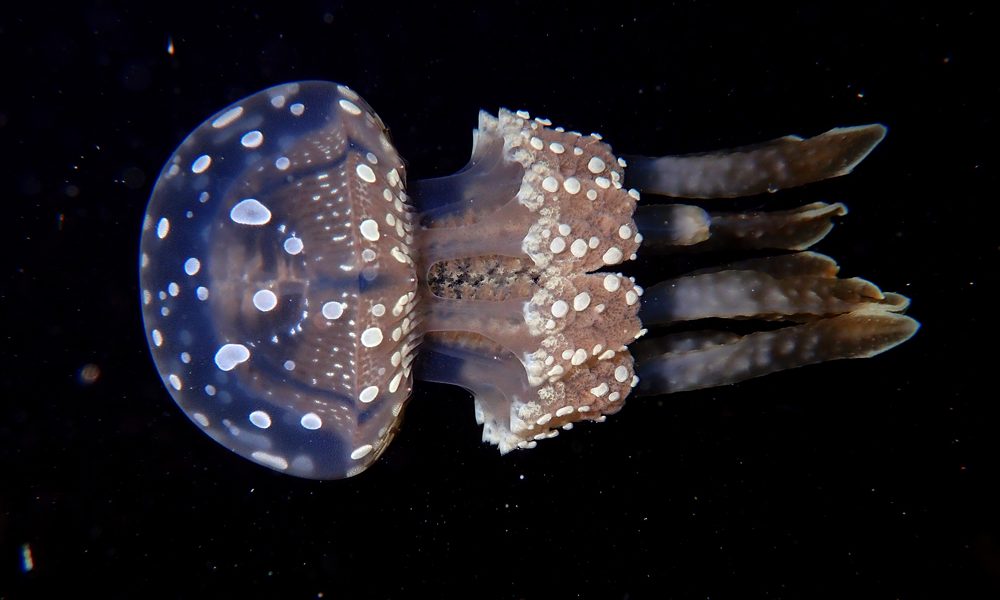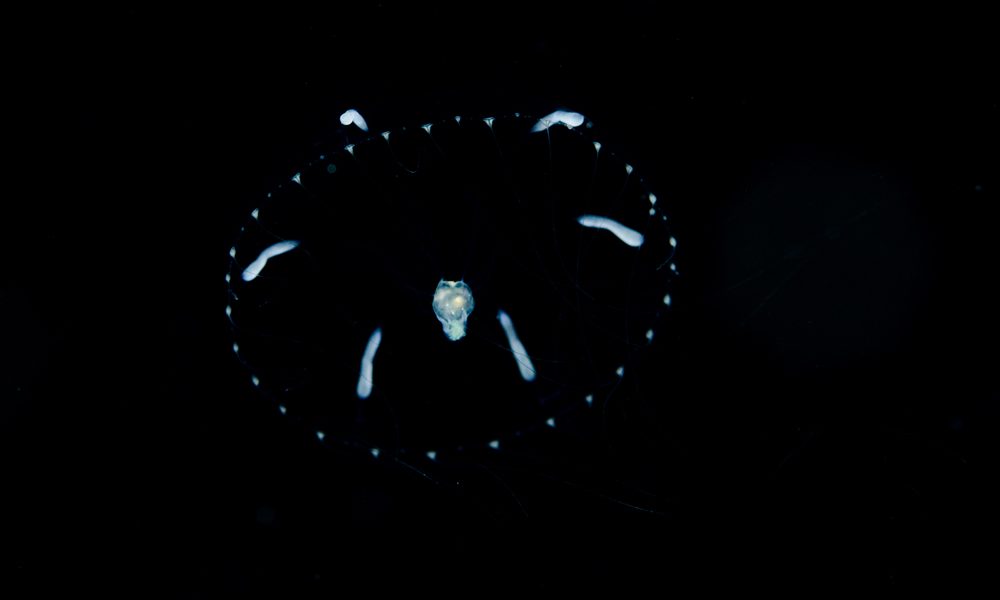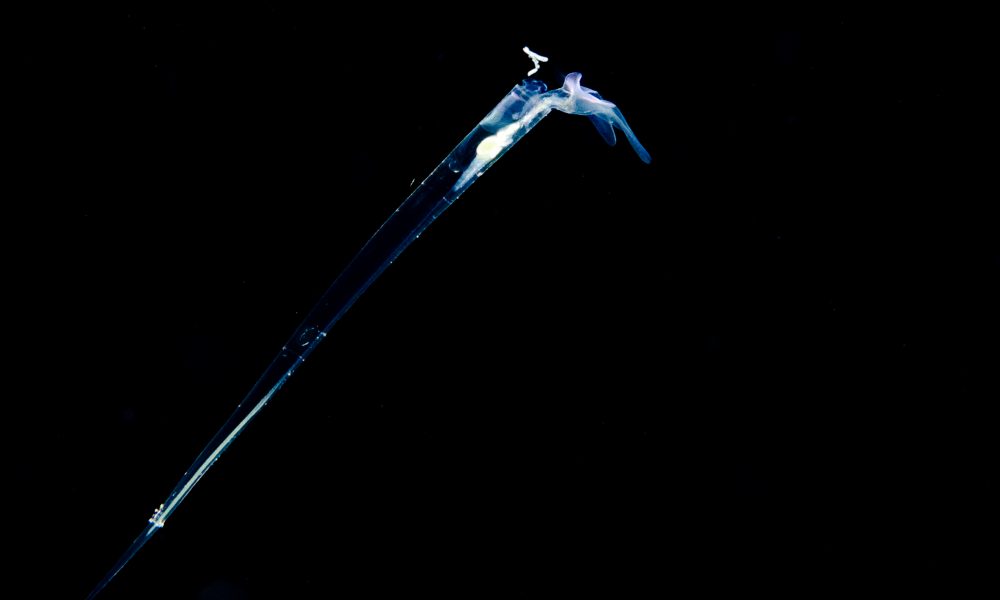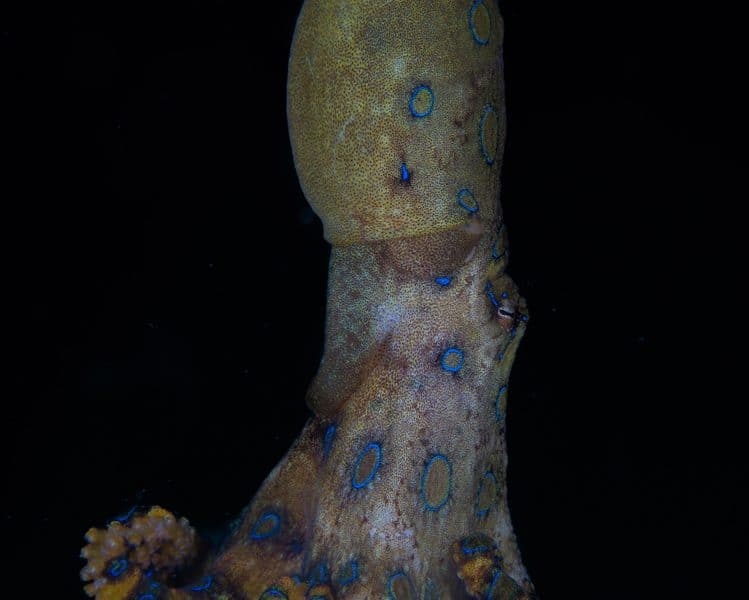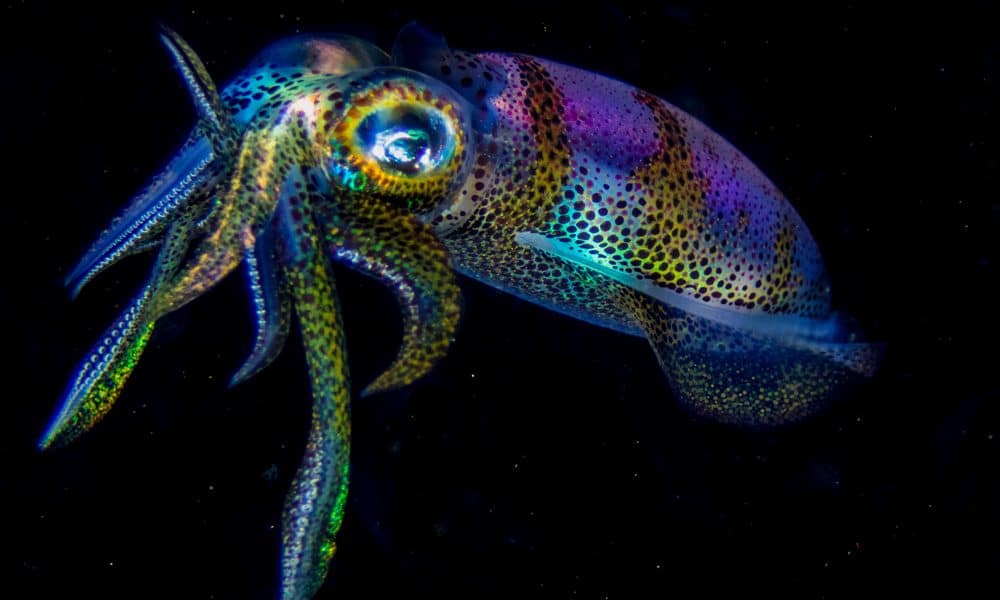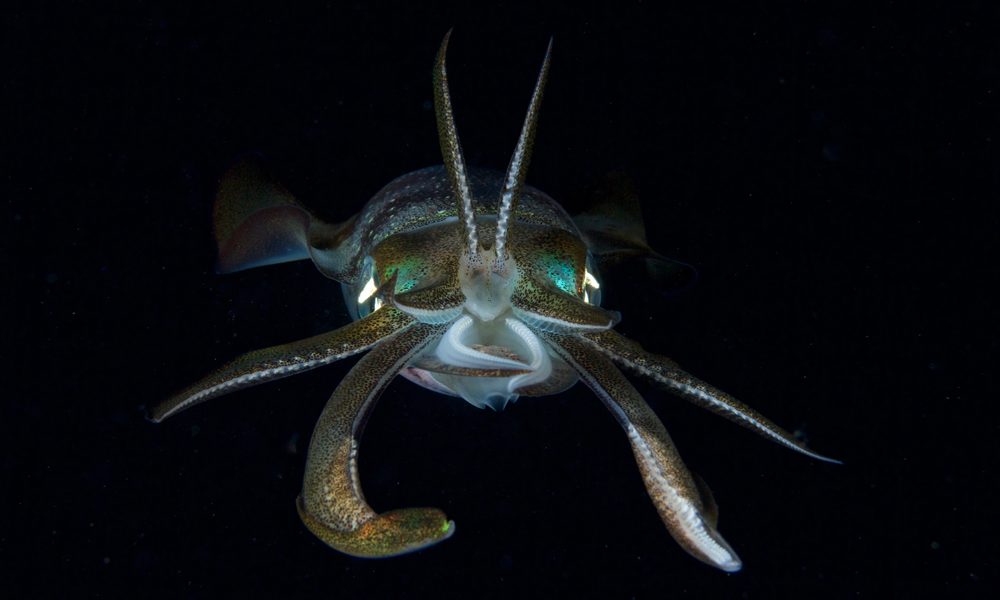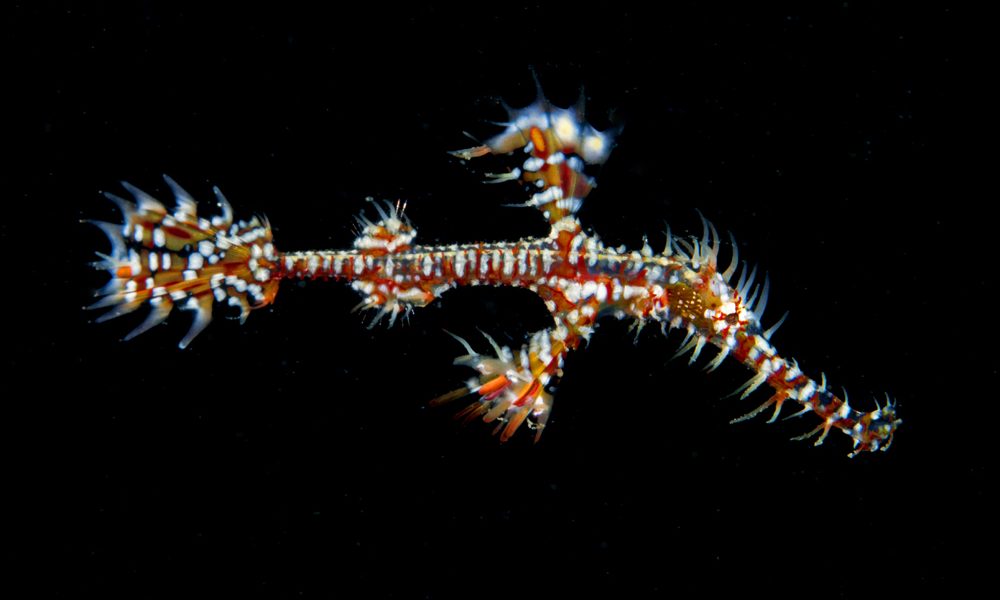Marine Life & Conservation Blogs
Black Water Diving with Magic Resorts
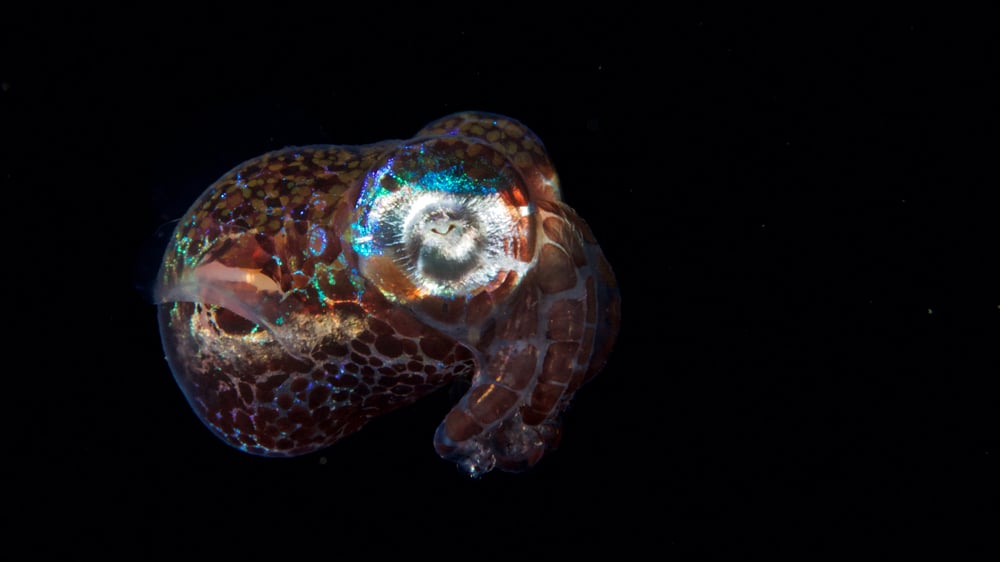
Floating, weightless surrounded by the blackness of the ocean at night time, that eery sensation of not knowing what lies beyond the glow of your flash light, that’s the first feeling I got on my very first Black Water Dive.
For many, I am sure Black Water Diving is a new term in the diving world, or maybe even something you have never heard of before, so what is it? Well, you head off into the middle of the ocean, where it’s deep. Really deep. At least 300m deep, and deeper seems to be better, of course its “Black Water” so this is at night time.
Diving out in the middle of the ocean at night has its concerns. The main one is the depth, you wouldn’t want anyone sinking down to the bottom. The second, is losing a diver. You’re out in the middle of nowhere and it’s dark. On the first attempts at Magic Island, we had the divers tethered to the boat via a 20m rope with a weight on the bottom and a carabiner clip attaching them to it. This allowed them to slide up-and-down the rope, but they couldn’t slide of the end due to the weight. The issue here is movement. The boat drifts along at a different speed and sometimes direction to the diver, depending on the current and the wind. This results in the divers been pulled along and unable to look at any creatures. In short; it doesn’t work and the freedom you get from diving is gone.
The fix to our issues was somewhat simple and a little scary, at first. After asking around to a few friends (thank you) we discovered you only need one line attached to a small buoy, not the boat, with a weight on the end. Then you need lots of lights and some strobes. The strobes are attached to the buoy, so the boat crew can easily keep watch. The flash lights are attached to the line at certain depths, we chose 7m, 14m and 21m which is the end of the line. Then you jump in and dive around the line. This helps with having a reference and more light to see stuff. And the stuff… that’s why you’re really here at this point, at this time of day.
That eery feeling, been lost at sea, sinking to the bottom of the ocean, all of these concerns soon go to the back of your mind as you become memorised by creatures you never imagined existed. Everywhere you look there’s something to see, the ocean out here is absolutely full of life. Jellyfish, siphonophores and comb jellies are a certain, and they all have their own beautiful display, from neon lights to strange flamboyant dances, or both. Cephalopods are also a common sight, especially small squid that dart around leaving jets of ink in the water as they get spooked. Less common is the paper nautilus, a pea sized animal that clings to debris drifting through the water column. I could fill the rest of the blog with all the critters you can see, but I wouldn’t want to spoil it for you.
The best way I can explain the feeling you get from black water dives, is to imagine mixing the nervous excitement you had when you took your first breaths underwater, and the sense of wonder and awe after completing your most amazing muck/critter dive. If your looking for the next adventure in the scuba world, make sure to visit Magic Island and book on a black water dive.
For more information about Magic Resorts visit their website by clicking here.
Written by: Jamie Gladwin – dive center manager and PADI Course Director at Magic Island Dive Resort.
Marine Life & Conservation Blogs
Creature Feature: Dusky Shark

 In this series, the Shark Trust will be sharing amazing facts about different species of sharks and what you can do to help protect them.
In this series, the Shark Trust will be sharing amazing facts about different species of sharks and what you can do to help protect them.
This month we’re taking a look at the Dusky Shark, a highly migratory species with a particularly slow growth rate and late age at maturity.
Dusky sharks are one of the largest species within the Carcharhinus genus, generally measuring 3 metres total length but able to reach up to 4.2 metres. They are grey to grey-brown on their dorsal side and their fins usually have dusky margins, with the darkest tips on the caudal fin.
Dusky Sharks can often be confused with other species of the Carcharhinus genus, particularly the Galapagos Shark (Carcharhinus galapagensis). They have very similar external morphology, so it can be easier to ID to species level by taking location into account as the two species occupy very different ecological niches – Galapagos Sharks prefer offshore seamounts and islets, whilst duskies prefer continental margins.
Hybridisation:
A 2019 study found that Dusky Sharks are hybridising with Galapagos Sharks on the Eastern Tropical Pacific (Pazmiño et al., 2019). Hybridisation is when an animal breeds with an individual of another species to produce offspring (a hybrid). Hybrids are often infertile, but this study found that the hybrids were able to produce second generation hybrids!
Long distance swimmers:
Dusky sharks are highly mobile species, undertaking long migrations to stay in warm waters throughout the winter. In the Northern Hemisphere, they head towards the poles in the summer and return southwards towards the equator in winter. The longest distance recorded was 2000 nautical miles!
Very slow to mature and reproduce:
The Dusky Shark are both targeted and caught as bycatch globally. We already know that elasmobranchs are inherently slow reproducers which means that they are heavily impacted by overfishing; it takes them so long to recover that they cannot keep up with the rate at which they are being fished. Dusky Sharks are particularly slow to reproduce – females are only ready to start breeding at roughly 20 years old, their gestation periods can last up to 22 months, and they only give birth every two to three years. This makes duskies one of the most vulnerable of all shark species.
The Dusky Shark is now listed on Appendix II of the Convention on the Conservation of Migratory Species (CMS), but further action is required to protect this important species.
Scientific Name: Carcharhinus obscurus
Family: Carcharhinidae
Maximum Size: 420cm (Total Length)
Diet: Bony fishes, cephalopods, can also eat crustaceans, and small sharks, skates and rays
Distribution: Patchy distribution in tropical and warm temperate seas; Atlantic, Indo-Pacific and Mediterranean.
Habitat: Ranges from inshore waters out to the edge of the continental shelf.
Conservation status: Endangered.
For more great shark information and conservation visit the Shark Trust Website
Images: Andy Murch
Diana A. Pazmiño, Lynne van Herderden, Colin A. Simpfendorfer, Claudia Junge, Stephen C. Donnellan, E. Mauricio Hoyos-Padilla, Clinton A.J. Duffy, Charlie Huveneers, Bronwyn M. Gillanders, Paul A. Butcher, Gregory E. Maes. (2019). Introgressive hybridisation between two widespread sharks in the east Pacific region, Molecular Phylogenetics and Evolution 136(119-127), https://doi.org/10.1016/j.ympev.2019.04.013.
Marine Life & Conservation Blogs
Creature Feature: Undulate Ray

 In this series, the Shark Trust will be sharing amazing facts about different species of sharks and what you can do to help protect them.
In this series, the Shark Trust will be sharing amazing facts about different species of sharks and what you can do to help protect them.
This month we’re looking at the Undulate Ray. Easily identified by its beautiful, ornate pattern, the Undulate Ray gets its name from the undulating patterns of lines and spots on its dorsal side.
This skate is usually found on sandy or muddy sea floors, down to about 200 m deep, although it is more commonly found shallower. They can grow up to 90 cm total length. Depending on the size of the individual, their diet can range from shrimps to crabs.
Although sometimes called the Undulate Ray, this is actually a species of skate, meaning that, as all true skates do, they lay eggs. The eggs are contained in keratin eggcases – the same material that our hair and nails are made up of! These eggcases are also commonly called mermaid’s purses and can be found washed up on beaches all around the UK. If you find one, be sure to take a picture and upload your find to the Great Eggcase Hunt – the Shark Trust’s flagship citizen science project.
It is worth noting that on the south coasts, these eggcases can be confused with those of the Spotted Ray, especially as they look very similar and the ranges overlap, so we sometimes informally refer to them as ‘Spundulates’.
Scientific Name: Raja undulata
Family: Rajidae
Maximum Size: 90cm (total length)
Diet: shrimps and crabs
Distribution: found around the eastern Atlantic and in the Mediterranean Sea.
Habitat: shelf waters down to 200m deep.
Conservation Status : As a commercially exploited species, the Undulate Ray is a recovering species in some areas. The good thing is that they have some of the most comprehensive management measures of almost any elasmobranch species, with both minimum and maximum landing sizes as well as a closed season. Additionally, targeting is entirely prohibited in some areas. They are also often caught as bycatch in various fisheries – in some areas they can be landed whilst in others they must be discarded.
IUCN Red List Status: Endangered
For more great shark information and conservation visit the Shark Trust Website
Image Credits: Banner – Sheila Openshaw; Illustration – Marc Dando
-

 News3 months ago
News3 months agoHone your underwater photography skills with Alphamarine Photography at Red Sea Diving Safari in March
-

 News3 months ago
News3 months agoCapturing Critters in Lembeh Underwater Photography Workshop 2024: Event Roundup
-

 Marine Life & Conservation Blogs2 months ago
Marine Life & Conservation Blogs2 months agoCreature Feature: Swell Sharks
-

 Blogs2 months ago
Blogs2 months agoMurex Resorts: Passport to Paradise!
-

 Blogs2 months ago
Blogs2 months agoDiver Discovering Whale Skeletons Beneath Ice Judged World’s Best Underwater Photograph
-

 Gear Reviews3 months ago
Gear Reviews3 months agoGear Review: Oceanic+ Dive Housing for iPhone
-

 Marine Life & Conservation2 months ago
Marine Life & Conservation2 months agoSave the Manatee Club launches brand new webcams at Silver Springs State Park, Florida
-

 News3 months ago
News3 months agoWorld’s Best Underwater Photographers Unveil Breathtaking Images at World Shootout 2023


